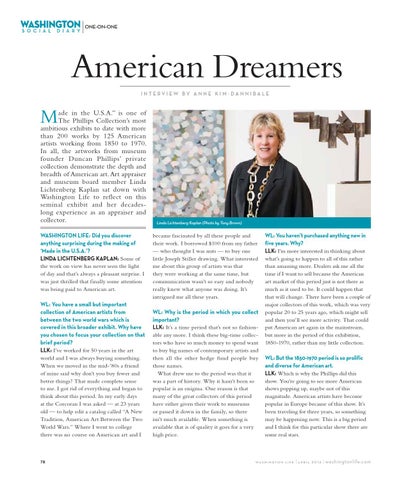ONE-ON-ONE
American Dreamers INTERVIEW BY ANNE KIM-DANNIBALE
M
ade in the U.S.A.” is one of The Phillips Collection’s most ambitious exhibits to date with more than 200 works by 125 American artists working from 1850 to 1970. In all, the artworks from museum founder Duncan Phillips’ private collection demonstrate the depth and breadth of American art. Art appraiser and museum board member Linda Lichtenberg Kaplan sat down with Washington Life to reflect on this seminal exhibit and her decadeslong experience as an appraiser and collector. WASHINGTON LIFE Did you discover anything surprising during the making of ‘Made in the U.S.A.’? LINDA LICHTENBERG KAPLAN Some of
the work on view has never seen the light of day and that’s always a pleasant surprise. I was just thrilled that finally some attention was being paid to American art. WL: You have a small but important collection of American artists from between the two world wars which is covered in this broader exhibit. Why have you chosen to focus your collection on that brief period? LLK: I’ve worked for 50 years in the art
world and I was always buying something. When we moved in the mid-’80s a friend of mine said why don’t you buy fewer and better things? That made complete sense to me. I got rid of everything and began to think about this period. In my early days at the Corcoran I was asked — at 23 years old — to help edit a catalog called “A New Tradition, American Art Between the Two World Wars.” Where I went to college there was no course on American art and I
78
Linda Lichtenberg Kaplan (Photo by Tony Brown)
became fascinated by all these people and their work. I borrowed $100 from my father — who thought I was nuts — to buy one little Joseph Stiller drawing. What interested me about this group of artists was that they were working at the same time, but communication wasn’t so easy and nobody really knew what anyone was doing. It’s intrigued me all these years. WL: Why is the period in which you collect important? LLK: It’s a time period that’s not so fashion-
able any more. I think these big-time collectors who have so much money to spend want to buy big names of contemporary artists and then all the other hedge fund people buy those names. What drew me to the period was that it was a part of history. Why it hasn’t been so popular is an enigma. One reason is that many of the great collectors of this period have either given their work to museums or passed it down in the family, so there isn’t much available. When something is available that is of quality it goes for a very high price.
WL: You haven’t purchased anything new in five years. Why? LLK: I’m more interested in thinking about
what’s going to happen to all of this rather than amassing more. Dealers ask me all the time if I want to sell because the American art market of this period just is not there as much as it used to be. It could happen that that will change. There have been a couple of major collectors of this work, which was very popular 20 to 25 years ago, which might sell and then you’ll see more activity. That could put American art again in the mainstream, but more in the period of this exhibition, 1850-1970, rather than my little collection. WL: But the 1850-1970 period is so prolific and diverse for American art. LLK: Which is why the Phillips did this
show. You’re going to see more American shows popping up, maybe not of this magnitude. American artists have become popular in Europe because of this show. It’s been traveling for three years, so something may be happening now. This is a big period and I think for this particular show there are some real stars.
WA S H I N G T O N L I F E
| A P R I L | washingtonlife.com
